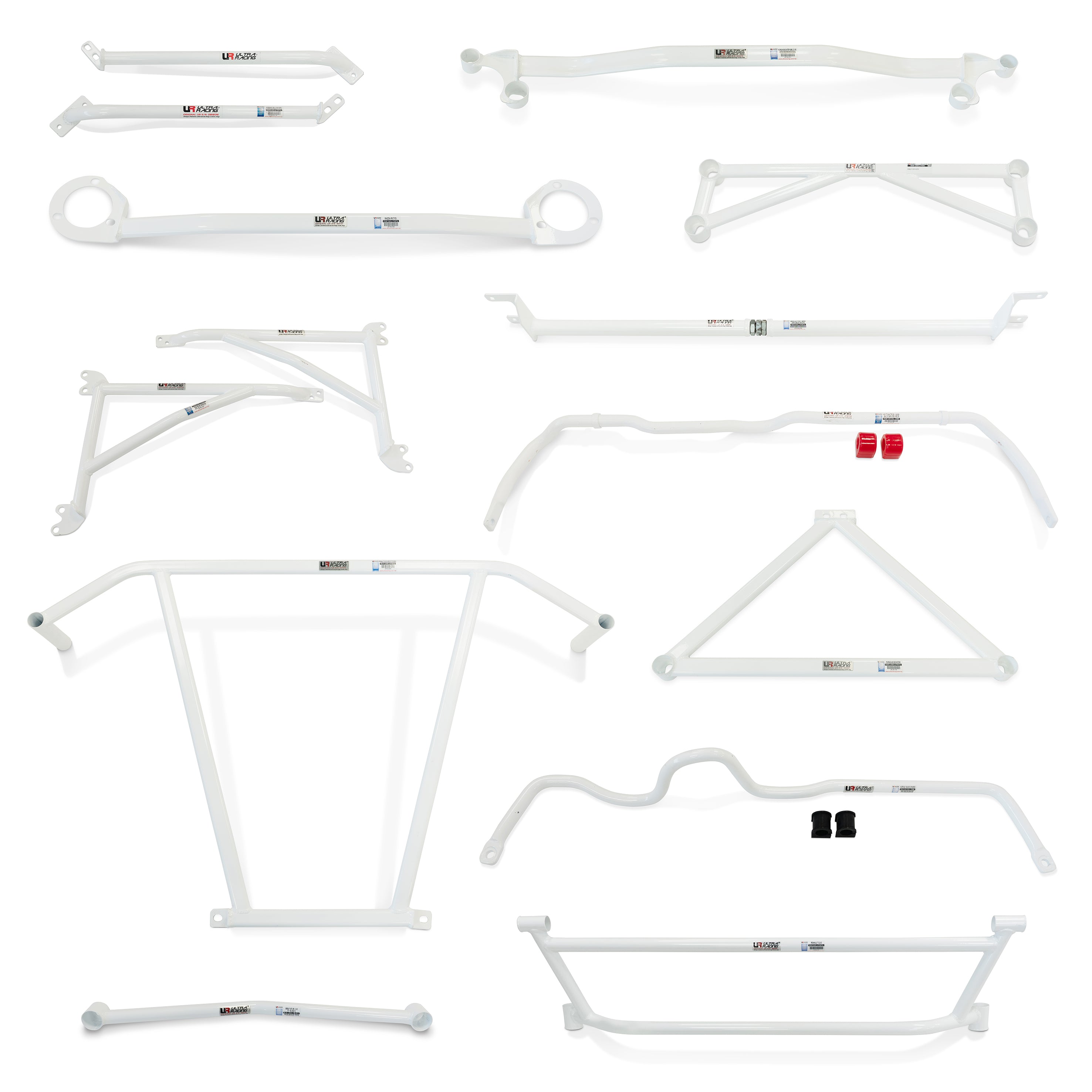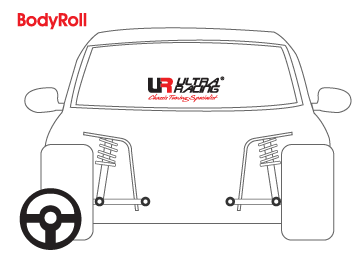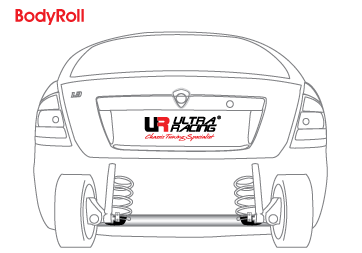
If you're truly dedicated to enhancing your car's handling performance, your first consideration should be lowering the suspension. For most enthusiasts, this modification alone is more than sufficient. However, if you're a passionate driver seeking even better handling, there are a couple of additional accessories worth considering.
The primary enhancement to explore is a strut brace. When you take corners, the chassis of your car experiences slight torsion. Specifically, in the front (and occasionally in the rear, although less frequently), the suspension pillars move relative to each other because they lack a direct physical connection. Instead, they rely on the car's body, which can flex based on its stiffness.
A strut brace is secured across the top of the engine, connecting to the summits of the two suspension posts and establishing that vital direct physical linkage. The outcome is a notably more rigid front suspension setup with minimal movement between each side. In essence, it acts as the missing fourth side, reinforcing the open box formed by the subframe and the two suspension pillars.

UNDERSTEER vs OVERSTEER
Understeer and oversteer are terms used to describe the handling characteristics of a vehicle, particularly during cornering.
Understeer occurs when a vehicle's front tires lose traction before the rear tires, causing the car to continue in a straighter path than intended when the driver turns the steering wheel. This often results in a "pushing" feeling and can be less responsive and potentially safer, but it can lead to a loss of control.
On the other hand, oversteer happens when the rear tires lose traction before the front tires, causing the vehicle to turn more sharply than intended, potentially leading to a spinout. It is generally considered more challenging to control but can be preferred by experienced drivers seeking precise handling. Understanding these dynamics is crucial for safe and effective driving, especially in adverse conditions or high-performance driving situations.
-
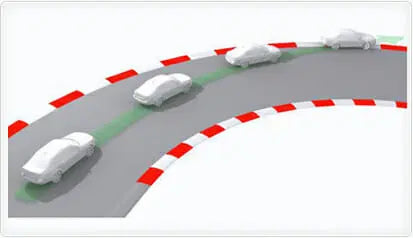
UNDERSTEER
The front wheels tend to slip towards the outside of the turn angle, and drivers may attempt to correct it by making a slightly sharper turn. However, this adjustment diminishes handling performance, makes the vehicle's behavior less predictable, and accelerates tire wear. Understeer is a common occurrence in front-wheel-drive vehicles.
-
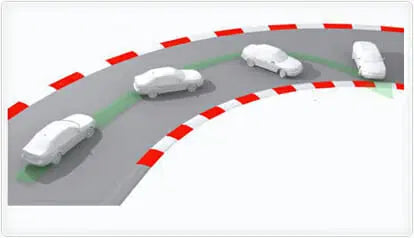
OVERSTEER
The rear wheels are prone to sliding towards the outside of the turn more than the front wheels. To prevent the vehicle from potentially spinning when pushed to its limits, the driver must counteract this by steering away from the corner. Oversteer is a frequent phenomenon in rear-wheel-drive vehicles.


STRUT BRACING
The Ultra Racing strut bar is an important and popular upgrade designed to enhance the structural integrity and handling performance of your vehicle.
The Ultra Racing strut bar reduces flex by connecting the front or rear strut towers, spreading the load. It serves a vital role in strengthening the vehicle chassis, contributing to improved stability and handling performance.
Ultra Racing strut braces are constructed using a fixed-mounted hollow tube design. The hollow tube design is not only lightweight but also incredibly strong, making it an ideal choice for
chassis reinforcement.
The increased chassis rigidity provided by the strut bar translates into more precise and responsive handling. Reducing chassis flex allows the suspension components to work more efficiently, helping the tyres to maintain better contact with the road surface. This, in turn, enhances grip and steering control, making the car feel more planted and predictable.
-
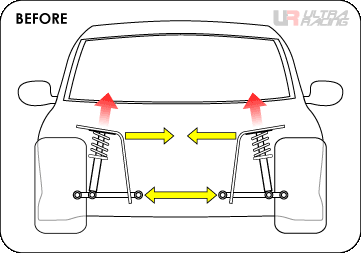
Upon impact, a portion of the shock is transmitted to the chassis, resulting in deformation of the wheelhouse and lower arm.
-
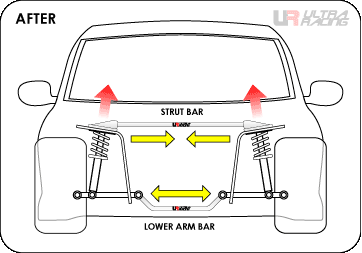
By equipping the Ultra Racing strut bar and lower arm bar, both sides will effectively neutralise the impact shock.
FENDER BARS
Ultra Racing’s fender bars strengthen the joint between the A-pillar and front chassis. In doing so they help to spread out the force and strengthen the section, preventing chassis damage and increasing handling performance.
By connecting the A-pillar to the front chassis, Ultra Racing fender bars effectively reinforce the structural integrity of this critical junction. The increased rigidity and stability provided by Fender Bars have a direct positive impact on the vehicle's handling dynamics. Stiffening the chassis in this manner reduces chassis flex during aggressive driving manoeuvres, resulting in improved handling stability.
-
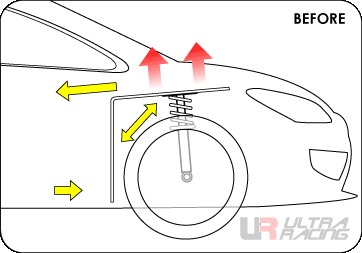
The joint between the A-pillar and the front chassis can experience significant push and torsion from the increased impact shock and drag force, potentially leading to chassis damage.
-
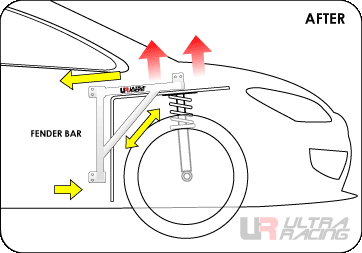
Ultra Racing's Fender bar effectively disperses and reinforces the force in this area, preventing additional damage and enhancing stability. It is highly recommended for users of sport absorbers.

ANTI ROLL BAR (ARB)
Ultra Racing anti-roll bars are designed to be slightly larger in diameter than their OEM counterparts to further stiffen the lower suspension parts to create a safer, more responsive drive.
Ultra Racing anti-roll bars are intentionally designed to have a slightly larger diameter than the stock or OEM bars. This increase in diameter results in a significant boost in stiffness. By doing so, Ultra Racing ARB’s reduce body roll during cornering, making the vehicle more stable and predictable.
When a vehicle takes a corner or swerves, weight transfers to one side, causing the suspension on that side to compress while the other side extends. This can lead to excessive body roll, adversely affecting handling and stability.
The stiffer Ultra Racing anti-roll bars counteract this by resisting the body roll, ensuring that both sides of the suspension work more evenly. This makes the driving experience not only safer but also more enjoyable, as it instils confidence and control.
-
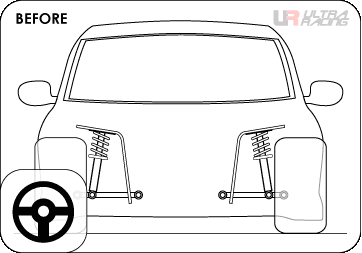
During cornering, weight transfer can lead to the car swaying to one side, resulting in increased body roll and making it more challenging to initiate a turn into a corner, thereby weakening the steering response.
-
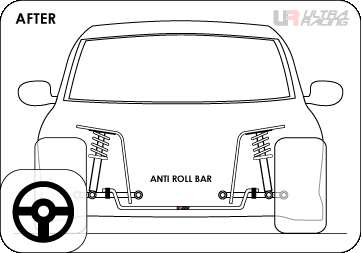
The upgraded version of Ultra Racing's anti-roll bar proves highly effective in preventing the car from swaying to the side during cornering. It significantly reduces body roll, ensuring enhanced stability while navigating corners.
LOWER CHASSIS BRACING
The Ultra Racing lower chassis braces are specifically designed to fit across the base of the vehicle. Typically (but not exclusively) installed across the subframe, Ultra Racing lower chassis braces reduce chassis twisting during acceleration and cornering. This results in improved handling performance.
During aggressive driving manoeuvres, such as hard acceleration and cornering, a vehicle's chassis can flex and twist. This flexing compromises the stability and responsiveness of the car. Ultra Racing lower chassis braces address this issue by connecting and reinforcing key structural points in the vehicle, effectively reducing chassis twisting.
The reduction in chassis twisting directly translates to improved handling performance. With a more rigid chassis, the suspension components can work more efficiently. The tires maintain better
contact with the road, resulting in enhanced grip, reduced body roll, and more precise steering response. This makes the vehicle feel more composed and predictable, which is especially valuable in fast road and track applications.
-
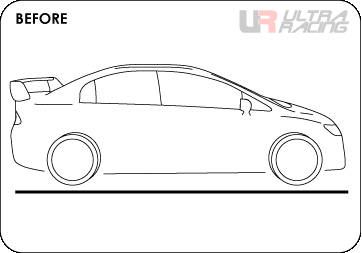
On uneven or bumpy roads, the central section of the chassis may exhibit varying degrees of body flex due to the weight transfer between the front and rear of the vehicle.
-
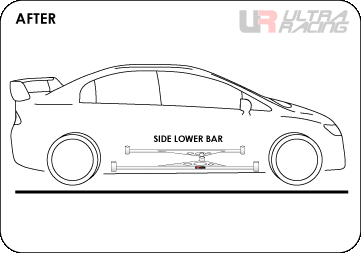
Ultra Racing's side lower bar effectively stabilizes the weight transfer between the front and rear of the vehicle, while also minimising potential damage from side impacts.
